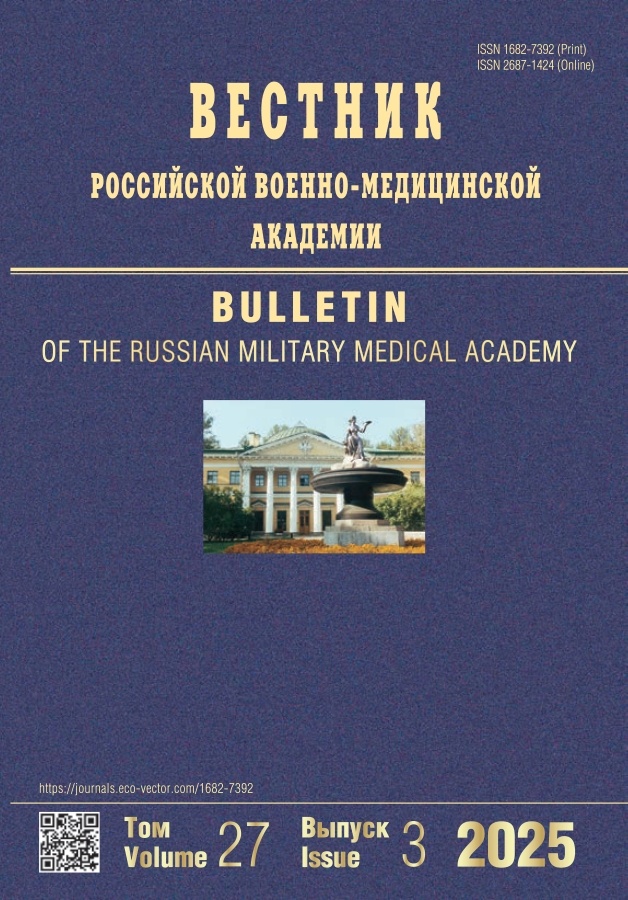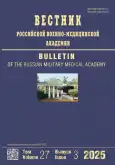Обоснование подходов к построению классификации боевых ранений черепа и головного мозга, нанесенных современным оружием
- Авторы: Орлов В.П.1, Мирзаметов С.Д.1
-
Учреждения:
- Военно-медицинская академия им. С.М. Кирова
- Выпуск: Том 27, № 3 (2025)
- Страницы: 321-330
- Раздел: Оригинальное исследование
- URL: https://bakhtiniada.ru/1682-7392/article/view/319563
- DOI: https://doi.org/10.17816/brmma678185
- EDN: https://elibrary.ru/KLLBGI
- ID: 319563
Цитировать
Аннотация
Обоснование. Классификация огнестрельных ранений черепа и головного мозга была разработана в период Великой Отечественной войны. Огнестрельные ранения настоящего времени отличаются от ранений прошлых войн еще большим их разнообразием, тяжестью, обширностью зоны поражения тканей черепа и головного мозга по периферии от раневого канала. Кроме того, разработаны новые методики диагностики, позволяющие выявить ранее не описанные ходы раневых каналов головного мозга, считавшимися, как правило, фатальными. Поэтому назрела необходимость в создании современной классификации огнестрельных ранений черепа и головного мозга.
Цель — усовершенствовать базисную классификацию огнестрельных ранений черепа и головного мозга и внести в нее современные клинико-анатомические особенности для построения развернутого клинического диагноза.
Методы. Проанализированы данные обследования и лечения двух групп раненых. Первую группу составили 127 раненых с огнестрельными черепно-мозговыми ранениями, лечившихся в условиях армейского специализированного госпиталя (Афганская война). Во вторую группу вошли 67 раненых (участники современного вооруженного конфликта), получивших лечение в клинике нейрохирургии Военно-медицинской академии им. С.М. Кирова.
Результаты. Разработана современная клинико-анатомическая классификация огнестрельных ранений черепа и головного мозга, в состав которой включены ранения задней черепной ямки (мозжечка и ствола головного мозга). На основании предложенной классификации появляется возможность проведения более точной по тяжести ранения медицинской сортировки раненых и определения очередности оказания им хирургической помощи, в том числе при массовом поступлении. Установлено, что в первую очередь в хирургической обработке нуждаются раненые, у которых раневой канал проходит через кору и белое вещество головного мозга. При этом чем более конвекситально проходит раневой канал, тем меньше повреждение головного мозга. После стабилизации жизненно важных функций операции выполняют тем раненым, у которых раневой канал проходит через 1-ю (подкорковые образования, желудочки и ствол головного мозга) и 2-ю (кора головного мозга и полушария мозжечка) зоны мозга. Прогноз у этой категории раненых будет зависеть от тяжести и объема повреждения жизненно важных структур головного мозга.
Заключение. Разработанная клинико-анатомическая классификация позволяет уточнить характер огнестрельных черепно-мозговых ранений, целенаправленно проводить медицинскую сортировку поступающих раненых, определять очередность оказания им хирургической помощи, а также определять прогноз и исход черепно-мозговых ранений.
Полный текст
Открыть статью на сайте журналаОб авторах
Владмир Петрович Орлов
Военно-медицинская академия им. С.М. Кирова
Email: vmeda-nio@mil.ru
ORCID iD: 0000-0002-5009-7117
SPIN-код: 9790-6804
д-р мед. наук, профессор
Россия, Санкт-Петербург, ул. Академика Лебедева, д. 6ЖСаидмирзе Джамирзоевич Мирзаметов
Военно-медицинская академия им. С.М. Кирова
Автор, ответственный за переписку.
Email: said19mirze@mail.ru
ORCID iD: 0000-0002-1890-7546
SPIN-код: 5959-1988
канд. мед. наук
Россия, Санкт-ПетербургСписок литературы
- Zhang JK, Botterbush KS, Bagdady K, et al. Blast-related traumatic brain injuries secondary to thermobaric explosives: implications for the war in Ukraine. World Neurosurgery. 2022;167:176–183. doi: 10.1016/j.wneu.2022.08.073 EDN: TDJOTQ
- Listratenko DA, Kardash AM, Fistal EY, et al. Diagnostics and treatment of patients with gunshot injuries of the skull and brain in the conditions of war in the megapolis. Vestnik Neotlozhnoi i Vosstanovitel''noi Khirurgii. 2020;5(3):94–103. (In Russ.) EDN: KLJXLJ
- Gizatullin SK, Stanishevskiy AV, Svistov DV. Combat gunshot skull and brain injuries. Burdenko's Journal of Neurosurgery. 2021;85(5):124–131. doi: 10.17116/neiro202185051124 EDN: OHHKSH
- Samokhvalov IM, Kryukov EV, Markevich VY, et al. Ten surgical lessons from the initial stages of a military operation. Military Medical Journal. 2023;344(4):4–10. doi: 10.52424/00269050_2023_344_4_4 EDN: DSYIAP
- Baum GR, Baum JT, Hayward D, MacKay BJ. Gunshot wounds: ballistics, pathology, and treatment recommendations, with a focus on retained bullets. Orthop Res Rev. 2022;14:293–317. doi: 10.2147/ORR.S378278 EDN: ANFESY
- Kalinich JF, Emond CA, Dalton TK, et al. Embedded weapons-grade tungsten alloy shrapnel rapidly induces metastatic high-grade rhabdomyosarcomas in F344 rats. Environ Health Perspect. 2005;113(6):729–734. doi: 10.1289/ehp.7791
- Hadrup N, Sørli JB, Sharma AK. Pulmonary toxicity, genotoxicity, and carcinogenicity evaluation of molybdenum, lithium, and tungsten: a review. Toxicology. 2022;467:153098. doi: 10.1016/j.tox.2022.153098 EDN: XKBWSX
- Aaronson DM, Awad AJ, Hedayat HS. Lead toxicity due to retained intracranial bullet fragments: illustrative case. J Neurosurg Case Lessons. 2022;4(13):CASE21453. doi: 10.3171/CASE21453 EDN: OCRPZZ
- Kırık A, Yaşar S, Durmaz MO. Prognostic factors in craniocerebral gunshot wounds: analysis of 30 patients from the neurosurgical viewpoint. Ulus Travma Acil Cerrahi Derg. 2020;26(6):859–864. doi: 10.14744/tjtes.2020.89947 EDN: LMJDNY
- Roy DS, Zhang Y, Halassa MM, Feng G. Thalamic subnetworks as units of function. Nat Neurosci. 2022;25(2):140–153. doi: 10.1038/s41593-021-00996-1 EDN: XCHHLK
- Fong H, Zheng J, Kurrasch D. The structural and functional complexity of the integrative hypothalamus. Science. 2023;382(6669):388–394. doi: 10.1126/science.adh848
- Tucker DM, Luu P. Adaptive control of functional connectivity: dorsal and ventral limbic divisions regulate the dorsal and ventral neocortical networks. Cereb Cortex. 2023;33(12):7870–7895. doi: 10.1093/cercor/bhad085 EDN: EZPUZS
- Trishkin DV, Kryukov EV, Alekseev DE, et al. Military field surgery. National leadership. 2nd ed. Moscow: GEOTAR media; 2024. 1056 p. (In Russ.) doi: 10.33029/9704-8036-6-VPX-2024-1-1056 EDN: AYGYWM
Дополнительные файлы















